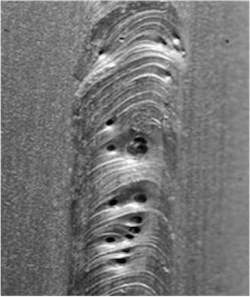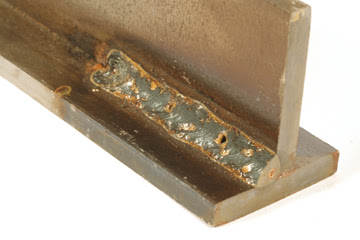Weld Defects and Weld Failures Encountered While Welding
Aluminium
Aluminium
Aim
To investigate the Weld defects and weld failures encountered
while welding Al.
Objective
1 To know the Weld Defects while welding Al.
2 To
know the Weld Failures while welding Al.
Abstract
Aluminum is a one-of-a-kind metal with its own
set of difficulties. Although tungsten is not necessarily more difficult to
weld than other metals, its unique problems need the adoption of specific
welding techniques. Weld flaws like as cracking and porosity have a significant
impact on the weld bead’s performance. The presence of porosity and cracking
was examined in samples taken after the LSM process with various manufacturing
settings. Porosity, lack of fusion, and burn through are some of the most
prevalent weld flaws, with aluminium posing a few more welding issues than
steel.
Introduction
Aluminum
transmits heat six times faster than steel, has excellent thermal conductivity,
and a low melting point, making it prone to warping and burn-through.
Furthermore, aluminium wire has a lower tensile strength than steel wire, which
might cause wire feeding issues and weld failures if the proper equipment is
not employed.
Weld Defects
1
Porosity
Porosity
The
molten weld pool is shielded from contamination by the surrounding atmosphere,
which would otherwise contaminate the weld. In the absence of shielding gas,
porosity (pinholes) on the weld bead form in the face and weld interior. A lack
of shielding gas can be caused by incorrect equipment settings, a hole in the
cannon liner, or the shielding gas being blown away by the wind.
Porosity while welding Aluminium
No Shielding Gas On Steel
A lack
of or inadequate shielding gas is easily identified by the porosity and
(pinholes) in the face and interior of the weld.
Using a
drag vs. a push approach on aluminium can result in a sooty looking weld (Above
Figure). Although the soot can be removed, breaking the weld up reveals
pinholes where impurities have become trapped. Before welding, aluminium
develops an oxide layer that must be removed. Cleaning aluminium with a wire
brush is the most popular approach, however it must be done using a stainless-steel
brush to avoid contaminating the weld with steel brush impurities.
Push vs. drag technique. On steel, either pushing or dragging
the gun is acceptable, but with aluminum, the drag technique will lead to weld
defects.
2 Burn through
A
high voltage or wire feed speed, as well as a sluggish travel speed, might
result in excessive heat input. This can cause warping or burn through,
particularly on thinner materials used in the sign business, with aluminium
being more susceptible than steel to the consequences. To reduce heat buildup,
aluminium requires a quicker travel speed than steel.
3 Craters
Craters
can form at the end of a weld with aluminium. They generate a stress point if
they aren’t filled in, which might lead to cracking. Although some welding
machines have a crater timer that will fill in the crater when the gun trigger
is released, this requires the user to swiftly trigger the gun again to fill in
the crater.
4 Lack of fusion
When
the voltage or wire feed speed is set too low, or when the operator’s travel
speed is too high, lack of fusion can result. Because aluminium conducts heat
more faster than steel, it is prone to fusion failure at the beginning of a
weld unless enough energy is applied. Some welding equipment compensates for
this by ramping up the current at the start of a weld and then lowering it to
prevent excessive heat buildup.
Feeding Aluminium
Feeding aluminium wire has been
compared to pushing a wet noodle through a straw due to its poor columnar
strength. The tangling of the wire between the drive roll and the liner, known
as “birdnesting,” is a common, time-consuming, and costly problem.
The operator must stop welding, cut the wire, discard the wire in the gun, and
refeed new wire through the liner to clear it. Because of the burnback created
when the wire stops feeding, it may also be necessary to clean or replace the
contact tip. Push only, spool gun, push-pull system, and continuous feed push
alone are all options for feeding aluminium wire.
Push only – Aluminum wire can be difficult to feed
through a push-only system, but it can be done on a limited basis. It
necessitates u-groove drive rolls for better surface contact with the wire, a
Teflon liner, sufficient drive-roll pressure, the ability to keep the gun cable
straight, and a strong pain tolerance.
Spool gun – A spool gun,
such as the Spoolmatic® 15A or 30A, eliminates the possibility of birdnesting
by putting a 4-inch (1-lb.) spool on the gun, so the wire only feeds a few
inches. Spool guns can accommodate aluminum wire diameters from .023 to
1/16-inch and allow the operator to use longer cables (15′-50′).
A spool
gun needs to have the roll changed after every pound of wire is used, compared
with the 8- or 15 lb spool on a push-pull system.
Push-pull gun – A motor in the gun pulls the wire through the
liner with a push-pull gun, while the motor in the welder or feeder control
acts as an assist motor. The push-pull method helps to prevent birdnesting by
keeping constant tension on the wire. It’s more ergonomic than a spool gun
because the spool’s weight isn’t in the operator’s hands.
unlike a spool gun, the spool needs to be changed less frequently, allowing for
the purchase of larger spools. However, keep in mind that after being exposed
to air for a while, aluminium forms an oxide coating. The smaller spool may be
a better alternative if you just need a pound or two of aluminium every week.
Preventions
1
Preventing Cracking
Preventing Cracking
Metal welding is
related with a number of distinct types of cracking. The two most well-known
types are hot and cold cracking. The creation of shrinkage cracks during the
solidification of a metal is known as hot cracking. Preventing hot cracking can
be as simple as using a filler metal with a reduced crack sensitivity weld metal
chemistry. You can also avoid hot cracking by ensuring that the joint design is
acceptable.
When hydrogen dissolves in the
weld metal and diffuses into the heat affected zone, cold cracking occurs. Cold
cracking is a significant problem that occurs at temperatures considerably
below 600°F. To avoid cold cracking, try pre-heating the base material to slow
down the cooling process. You can also utilise low-hydrogen welding consumables
to reduce the amount of hydrogen that diffuses into the weld.
2 Preventing Burn-Through or Poor Penetration
Applying too much
heat to metal and burning a huge gap in it causes burn through. Welding
requires adequate heat to properly fuse the metals, thus if a welder fails to
balance heat and speed, burn through can occur. When TIG welding aluminium, use
a low amperage and a long point on the electrode to avoid burn through. Use a pulsed
gun while MIG welding metal. To avoid burn-through, it will give enough heating
and cooling at the appropriate intervals.
3 Preventing Porosity
Metal pollution in
the form of trapped gas is known as welding porosity. Shielded gases are
absorbed by the molten metal and then expelled as it solidifies. Weak,
bubble-filled welds that do not meet code and, more critically, can cause
elements of a project to become weak and collapse are examples of porosity in
welding. Prior to welding, weld preparation of pipe surfaces can be crucial.
Aquasol created EZ Wipes to eliminate the fear of contamination surrounding the
weld zone and to assure a high-quality weld. Our cleaning wipes concentrated
cleaning liquid makes it easier to remove fluid lubricants, oils, inks, grease,
and some adhesives, which helps to reduce porosity in welding.
References
(1)
https://www.millerwelds.com/resources/article-library/the-most-common-mig-weld-defects-on-aluminum-and-steel-and-how-to-avoid-them
https://weldguru.com/gmaw-welding-defects/
https://www.sciencedirect.com/topics/engineering/weld-defect
https://inbound.cammmetals.com/blog/what-are-the-challenges-of-welding-aluminum
https://www.sciencedirect.com/topics/materials-science/welding-defect
https://www.aquasolwelding.com/aluminum-welding-procedure




This comment has been removed by the author.
I am very thankful to you that you have shared this information with us. I got some different kind of knowledge from your web page, and it is really helpful for everyone. Thanks for share it. Buy Telwin TIG Welding Kit